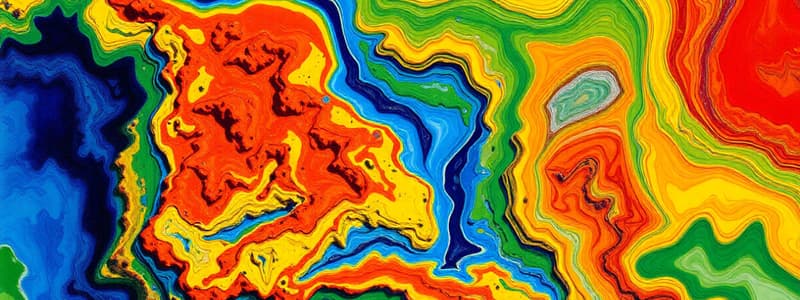Podcast
Questions and Answers
Which of the following is NOT a key concept in geography?
Which of the following is NOT a key concept in geography?
- Place
- Sustainability (correct)
- Location
- Scale
Which of the following best describes the interdisciplinary nature of geography?
Which of the following best describes the interdisciplinary nature of geography?
- Geography draws upon multiple disciplines to understand spatial patterns and relationships. (correct)
- Geography relies heavily on specific data from only one field of study.
- Geography does not consider the influence of human activity.
- Geography only focuses on physical features of the Earth.
What is the primary focus of transportation geography?
What is the primary focus of transportation geography?
- The development of sustainable modes of transportation.
- The impact of transportation systems on the environment.
- Transportation geography focuses on the spatial organization of transportation systems and their effects on the environment, society, and economy.
- The history of transportation infrastructure.
- The spatial organization of transportation systems and their effects. (correct)
Which of the following concepts describes the interconnectedness of places through trade, communication, and cultural exchange?
Which of the following concepts describes the interconnectedness of places through trade, communication, and cultural exchange?
What does the concept of 'scale' refer to in geography?
What does the concept of 'scale' refer to in geography?
Which branch of geography focuses on the study of weather patterns and climate systems?
Which branch of geography focuses on the study of weather patterns and climate systems?
What is the primary focus of population geography?
What is the primary focus of population geography?
Which of the following is NOT a key area of study within physical geography?
Which of the following is NOT a key area of study within physical geography?
Which branch of geography examines the spatial aspects of political systems, including state boundaries and governance?
Which branch of geography examines the spatial aspects of political systems, including state boundaries and governance?
What is the main difference between physical geography and human geography?
What is the main difference between physical geography and human geography?
Which of these is a key aspect of studying coastal geography?
Which of these is a key aspect of studying coastal geography?
What is the primary focus of environmental geography?
What is the primary focus of environmental geography?
The study of how soil is formed, its properties, and its distribution falls under which branch of geography?
The study of how soil is formed, its properties, and its distribution falls under which branch of geography?
Flashcards
Transportation geography
Transportation geography
The study of transportation systems' spatial organization and their impacts on the environment, society, and economy.
Interdisciplinary geography
Interdisciplinary geography
Geography integrates concepts from biology, geology, sociology, economics, and political science.
Location
Location
A position on Earth, described as absolute (latitude/longitude) or relative (to other places).
Globalization
Globalization
Signup and view all the flashcards
Human-environment interaction
Human-environment interaction
Signup and view all the flashcards
Geography
Geography
Signup and view all the flashcards
Physical Geography
Physical Geography
Signup and view all the flashcards
Climatology
Climatology
Signup and view all the flashcards
Hydrology
Hydrology
Signup and view all the flashcards
Biogeography
Biogeography
Signup and view all the flashcards
Economic Geography
Economic Geography
Signup and view all the flashcards
Urban Geography
Urban Geography
Signup and view all the flashcards
Cultural Geography
Cultural Geography
Signup and view all the flashcards
Study Notes
Introduction to Geography
- Geography is the study of the Earth's surface, including its physical features, climate, inhabitants, and human activities.
- It examines the spatial distribution of these elements and their interactions.
- Geography is often divided into two main branches: physical geography and human geography.
Physical Geography
- Physical geography focuses on the Earth's natural environment, landforms, and processes.
- Key areas of study include:
- Climatology: The study of weather patterns and climate systems – including temperature, precipitation, wind patterns, and atmospheric conditions.
- Hydrology: The study of water on Earth, encompassing rivers, lakes, groundwater, and oceans.
- Geomorphology: The study of landforms and the processes that shape them, like erosion, weathering, and tectonic activity.
- Biogeography: The study of the distribution of plants and animals across the Earth's surface, considering environmental factors.
- Glaciology: The study of glaciers, ice sheets, and ice caps.
- Soil science: The study of soil formation, properties, and distribution.
- Coastal geography: Examines coastal processes and landforms, including erosion, sedimentation, and sea level changes.
- Environmental geography: Looks at interactions between humans and the environment, including environmental issues like pollution, climate change, and resource management.
Human Geography
- Human geography analyzes human activities and their impact on the Earth's surface.
- Key areas of study include:
- Population geography: Focuses on population distribution, density, growth, and migration patterns.
- Economic geography: Examines the spatial organization of economic activities, including industries, trade, and development.
- Urban geography: Studies the growth, structure, and functions of cities and urban areas.
- Political geography: Investigates the spatial aspects of political systems, including state boundaries, governance, and international relations.
- Cultural geography: Analyzes the spatial distribution of cultural traits, including language, religion, and customs.
- Social geography: Explores the spatial aspects of social processes, such as class, gender, and ethnicity.
- Tourism geography: Examines the geographical aspects of tourism, including tourist flows, destinations, and impacts.
- Transportation geography: Focuses on the spatial organization of transportation systems and their effects on the environment, society and economy.
Interdisciplinary Nature of Geography
- Geography is an interdisciplinary field, drawing on principles from other subjects like biology, geology, sociology, economics, and political science.
- It uses various tools and techniques, like maps, remote sensing, and GIS (Geographic Information Systems) to analyze and understand spatial patterns.
Key Concepts in Geography
- Location: Position on Earth's surface, absolute (latitude/longitude) or relative (in relation to other places).
- Place: A specific point on Earth with unique characteristics (physical and human).
- Space: A three-dimensional area, often characterized by interactions between people and environments.
- Region: An area with shared characteristics (physical or cultural).
- Globalization: Interconnectedness of places through trade, communication, and cultural exchange.
- Scale: The level of detail examined, from local to global.
- Spatial interaction: Flows of people, goods, and information between different places.
- Distribution: Patterns of phenomena across a geographic area.
- Pattern: Regular or irregular arrangement of geographic features.
- Movement: Flow of people, goods, or ideas across space.
- Human-environment interaction: The complex relationship between humans and their physical environment.
- Sustainability: The ability to meet current needs without compromising the ability of future generations to meet their own needs.
Studying That Suits You
Use AI to generate personalized quizzes and flashcards to suit your learning preferences.




